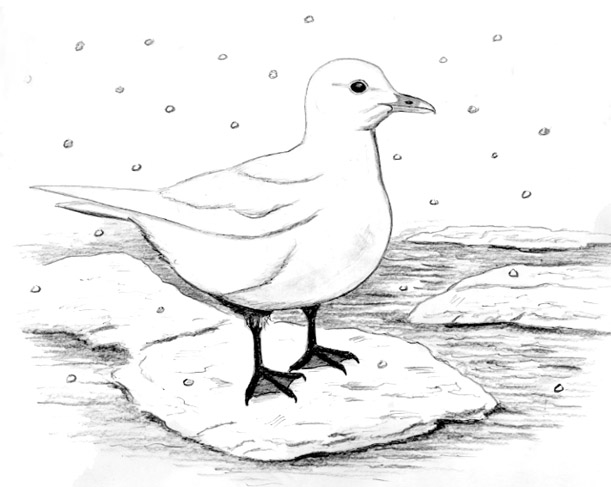
Dear Bird Folks,
What is the dealeo with bird watchers and the word “ivory”? A few years ago they got all worked up over a possible sighting of an Ivory-billed Woodpecker. This past week there were stories in The Boston Globe, the Cape Cod Times, and on TV about an Ivory Gull that once again has birders in a tizzy. Are we going to have to go through this hoopla every time a bird with “ivory” in its name makes an appearance?
– Todd, Hyannis, MA
Calm down, Todd,
Give us a break, will ya? We’re bird watchers. Birds are what we are supposed to get worked up over. I know studying birds may not be as important as sitting on the couch watching American Idol, but it’s what we do. And while I admit that bird watchers are a bit odd, I don’t know a single one of them who uses the words “dealeo,” “tizzy,” or “hoopla.” Even we aren’t that weird. Just thought I’d point that out.
I have to agree with you about one thing, though. The Ivory Gulls did grab a lot of media attention, more than most bird sightings usually do. But I think the timing had something to do with it. The sightings happened between the swearing-in of the new president and the upcoming Super Bowl. So it was kind of a slow news time. Actually, it’s a good thing these gulls arrived when they did or we would have to listen to more stories about which dresses were worn at the inaugural balls. You should thank these gulls for showing up.
For those of you who missed the gull media blitz, here’s the scoop. Last week, perhaps for the first time ever, two adult Ivory Gulls were spotted in Massachusetts (one in Gloucester and one in Plymouth Harbor). As their name implies, Ivory Gulls are white. But they are not ivory white, they are bright white, gleaming white, snow white (only without the seven dwarfs). The white seems to glow off them. I think the only things I’ve ever seen that are whiter than these Ivory Gulls are my cousins in Ireland.
The reason why the Ivory Gull is white has to do with its environment. This bird is normally found in the distant polar regions of the Northern Hemisphere. It lives in parts of Canada that are so far north that even Canadians don ‘t know about these places. This gull only wants to be around snow and ice and will even build its nests above glaciers. When feeding it likes to hang around pack ice, eating fish that also like to hang around pack ice. The white plumage allows the bird to totally blend in with the surrounding snow. The only parts of the bird that aren’t white are its small black feet, dark eyes, and a bill that is blue, probably from being cold all the time.
In addition to eating ice-loving fish, the Ivory Gull does what any self-respecting gull would do, it scavenges. However, there are no landfills or McDonald’s parking lots to mooch off of where this bird calls home. So instead it searches for leftover seals. Polar bears are good at catching seals and Ivory Gulls are good at cleaning up after polar bears.
While most unusual avian visitors are a challenge to photograph, the Ivory Gull is more than cooperative when it comes to posing for pictures. Since it rarely sees people, it doesn’t have any reason to avoid us. The day my friend, Fahy, and I went to see the bird in Plymouth Harbor there was a wall of photographers already there ahead of us. I immediately focused my binoculars on the same location that the photographers had their cameras trained on. I saw loons, golden-eyes and Buffleheads, but no gull. Swell. I had missed another cool bird. As I stood there with the usual dopey look on my face, a very nice lady from Western Mass. walked up to me and asked: “Are you looking for the gull?” I politely replied: “Yes,” but I was thinking: “Well, duh! I’m not here looking for Plymouth Rock.” She said: “Just look down,” but I know she was thinking: “You stink at birding.” I looked down and there, standing two feet in front of the photographers, was the Ivory Gull. The bird, which truly was as shockingly white as the books claim, had zero fear of the odd-looking humans and their cameras. Why weren’t the photo folks taking its picture? Since the gull was so tame, they had taken all pictures they needed in the first two minutes and now were entertaining themselves by shooting pics of loons, golden-eyes and Buffleheads. Remember, they were photographers and not birders. The birders never stopped studying the bird.
The excitement caused by the visit of the two Ivory Gulls has nothing to do with the word “ivory,” Todd. It has to do with seeing a bird that normally lives in extremely remote locations and even in those locations it is rare due to a declining population. For many birders, even hardcore birders, this may be their only chance to ever see this beautiful bird, which may one day only be found in museums. And speaking of museums, they should build one to keep words that no one ever uses anymore. You know, words like dealeo, tizzy and hoopla.